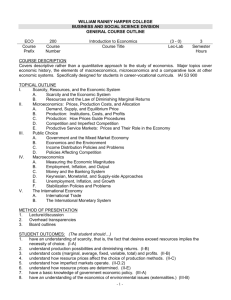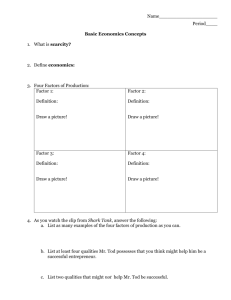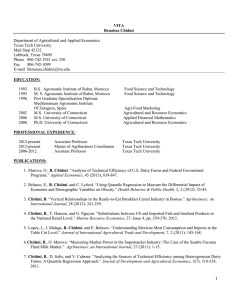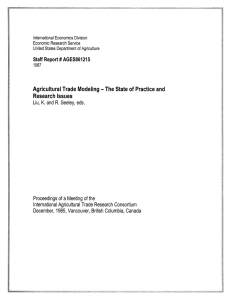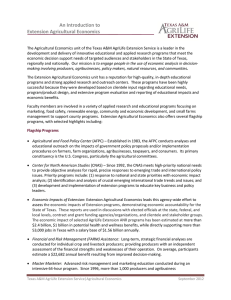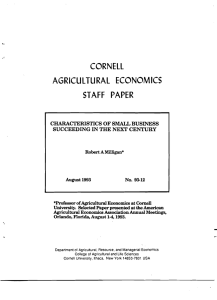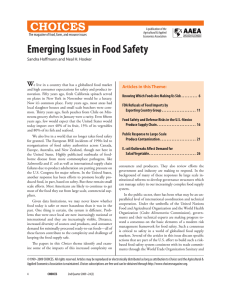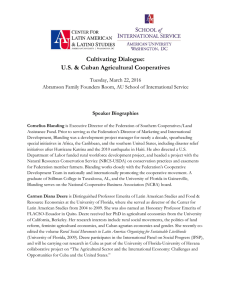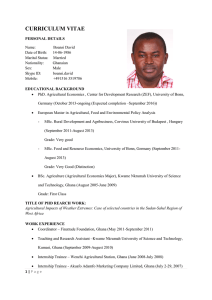PowerPoint
advertisement
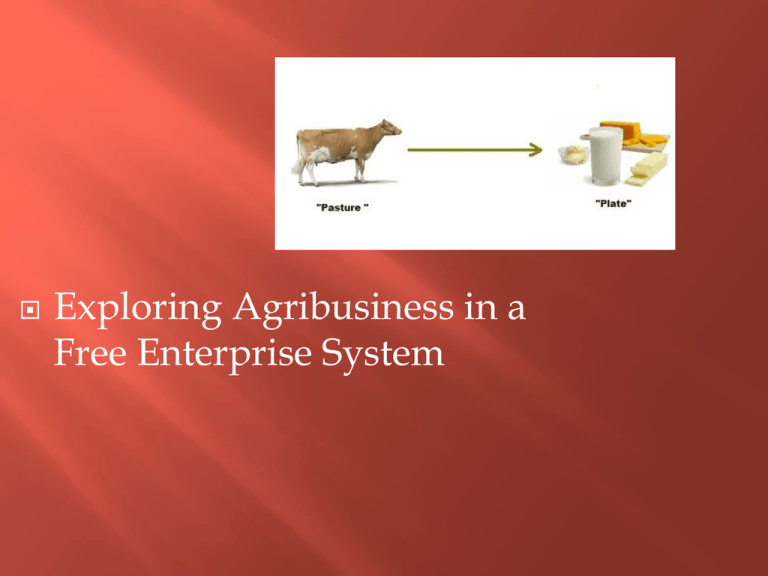
Exploring Agribusiness in a Free Enterprise System RST.6‐8.2 - Determine the central ideas or conclusions of a text; provide an accurate summary of the text distinct from prior knowledge or opinions. (MS‐LS1‐6) WHST.6‐8.1 - Write arguments to support claims with clear reasons and relevant evidence. (MSLS2‐4) SL.8.1 - Engage effectively in a range of collaborative discussions (one‐on‐one, in groups, and teacher‐led) with diverse partners on grade 8 topics, texts, and issues, building on others’ ideas and expressing their own clearly. (MS‐LS2‐2) SL.8.4 - Present claims and findings, emphasizing salient points in a focused, coherent manner with relevant evidence, sound valid reasoning, and well‐chosen details; use appropriate eye contact, adequate volume, and clear pronunciation. (MS‐LS2‐2) Pathway Content Standard: The student will demonstrate competence in the application of principles and techniques for the development and management of agribusiness systems. ABS.01. Performance Element: Utilize economic principles to establish and manage an AFNR enterprise. ABS.01.01. Performance Indicator: Apply principles of capitalism in the business environment. ABS.01.01.01.a. Recognize principles of capitalism as related to AFNR businesses. Designer clothes, food, nike shoes, diamond rings, your favorite music group’s compact disc, notebook for ag class. Make a list of your own wants and needs include the above items. We will discuss what items you consider to be needs and what items you consider to be wants. Agricultural economics Allocates Capitalism Communism Economics Fascism Free enterprise Free resources Needs Products Resources Scarcity Services Socialism Subsidies Wants The science that deals with the production, distribution, and consumption of wealth. There are three different components of economics: Scarcity 2. types of resources 3. wants and needs. 1. The situation where resources are lacking. Economics studies the way society allocates, or distributes, its scarce resources. Not all resources are scarce, those that are readily available are called free resources. Shortage and scarcity are not the same. Scarcity exists as a result of limitations of a resource. A shortage is a temporary situation. Resources are items ready to use at any time. Resources considered factors of production include land, labor, capital, and management. These resources are used to make products and provide services. Products are the goods produced to meet the needs of customers. Services are activities provided to consumers for a fee. Needs are things needed for daily living, food and shelter for example. Wants are things that are not necessary for daily living. The differentiation between wants and needs proves interesting, because the more people get, the more they want. What goods should be produced and how much of each? How should the goods be produced? Who should get what? Traditional system, capitalism, socialism, fascism, communism and mixed economic system The difference between each is the level of control by individuals versus by government. Is an economic system where things are done according to how they’ve been done in the past. Decisions are based on beliefs handed down for generations. An economic system where the individual owns the resources and can use their time and resources as they want. Government involvement is low, the individuals must be self-regulating. Private ownership allows for competition. Is an economic system where the public has ownership of all productive resources. In this system, the government is responsible for making all of the production decisions. The state establishes prices, thus eliminating competition. Individuals own the resources but produce goods as directed by the government. Individuals who support the government have more economic power than those who do not. This allows the government to have complete control over nearly all aspects of business. Is an economic system where one party controls all means of production. Private individuals have no control over resources. The government exercises complete control of the economy. Characteristics of the free enterprise system. 1. little or no government control 2. freedom of enterprise 3. Freedom of choice 4. the right to own property, 5. profit incentive 6. chance for competition. Government’s role in a free enterprise system is to regulate and protect the public while keeping the economy in balance. Individuals own and have choices over their resources, but must do so within the limits of the law. Free enterprise refers to an individual’s freedom to own and control production of resources. Americans have freedom of choice within the U.S. economic system. Freedom of choice means freedom to make decisions about what should be produced. However, government has set safety standards meant to protect consumers. The government also regulates utilities. Americans have the right to own private property including land, automobiles, and more. There is no limit on how much you can own outside your own budget limitations. Profits you make as a result of your private property are yours to keep after reasonable taxation. Profit incentive is the ability to make a profit from the private property you own. Profit drives people to produce more products for others to buy. Competition is a rivalry for a business’s customers or markets. Businesses survive based on their ability to produce products competitively. Ag econ is the application of economic principles to agricultural problems. The main emphasis of agricultural economics is farm production. However, it includes the entire agricultural industry. Agricultural economics includes agricultural finance, rural development, and agricultural policy. What are the three major components of economics. Name and describe the six types of economic systems. List the characteristics of the American economy. Agricultural economics includes the study of what three things



